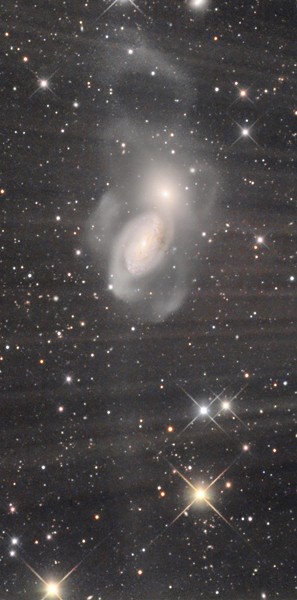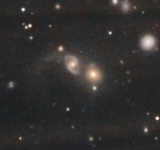|
|
 |

|
|
Instrument |
12.5" RCOS @
~f/9 (2880 mm fl) 1.28 arcsec / pixel. Zoomify image scale is
1.28 to 3.33 arcsec / pixel. |
|
Mount |
Paramount ME |
|
Camera |
SBIG STL-11000 w/ internal filter wheel, AstroDon Filters |
|
Acquisition Data |
3/15/2010 to 4/13/2010 Chino Valley, AZ... with CCDAutoPilot3 & CCDSoft. |
|
Exposure |
Lum
360 min (24 x 15 min, bin 2x2)
RGB
270 min ( 6 x 15 min each, bin 2x2) |
|
Software |
-
CCDSoft, CCDStack,
Photoshop CS w/ the Fits Liberator plugin. Noel Carboni's actions
and Russell Croman's GradientXTerminator.
-
eXcalibrator for (u-g), (g-r) color calibration, using 7 stars from
the SDSS database.
-
PixFix32 (pre-beta) to
repair hot/cold pixels and column defects.
-
CCDStack to calibrate,
register, normalize, data reject, combine the sub exposures, LRGB
color, and luminance deconvolution.
-
PhotoShop for LLRGB
combine &
on-linear stretching.
|
|
Comment |
North is to the top.
NGC 3227 is a spiral
galaxy that is interacting with the dwarf elliptical galaxy NGC
3226. The galaxies are located in the constellation Leo, at a
distance of about 66 and 73 million light-years respectively. The interaction between the two galaxies has formed an
interesting looping tidal tail to the north. Although not visible in
the upper image, there is a long thin tail extending straight down,
to the south, from NGC 3227.
The lower-left, highly stretched image clearly shows the extent of
the northern tidal loop and the long tidal tail to the south.
Unfortunately, the light rays, from the nearby magnitude 2 star
Algieba, are also greatly enhanced.
To the right, and down 24 degrees, is a more distant pair of
galaxies that appear to be interacting... with PGC 30397 on the left
and PGC 1605532 to the right. The two galaxies are at distance of
about 595 million light-years. To the left of PGC 30397, a possible
large arching tidal tail is visible. There is also a much fainter
tail directly south of PGC 1605532, but this may be the result of
the author's imagination. |
|